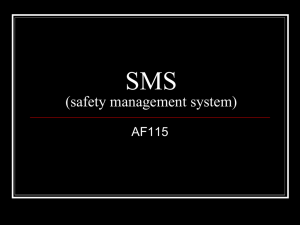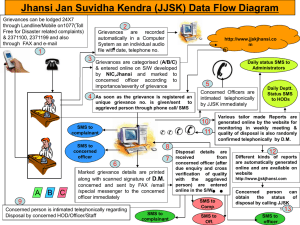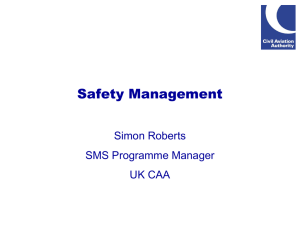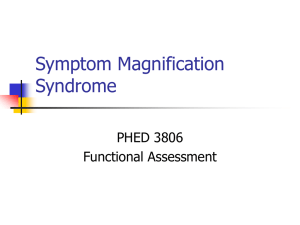ICAO SMS Module 05
advertisement
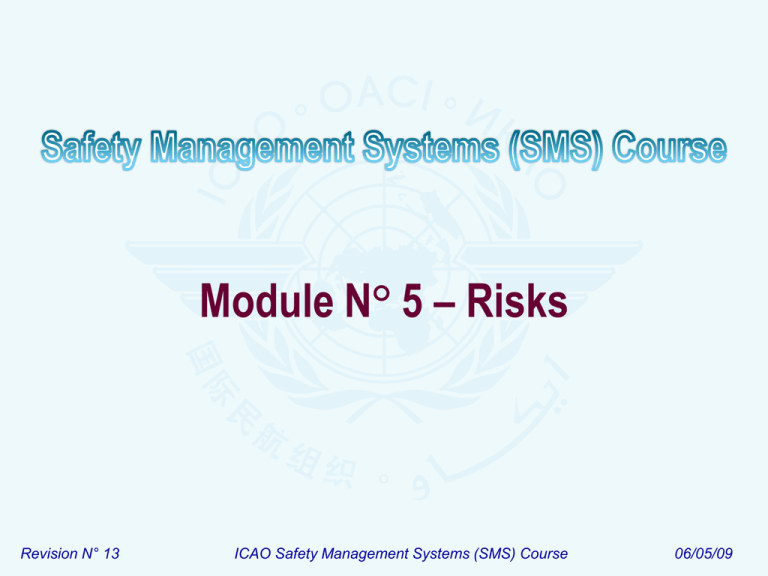
Module N° 5 – Risks Revision N° 13 ICAO Safety Management Systems (SMS) Course 06/05/09 Course structure Safety Management System Module 8 Module 10 Phased approach to SSP and SMS Implementation SMS planning Module 5 Risks Module 1 SMS course introduction Module N° 5 Module 9 SMS operation Module 6 SMS regulation Module 2 Basic safety concepts Module 7 Introduction to SMS Module 3 Introduction to safety management ICAO Safety Management Systems (SMS) Course Module 4 Hazards ‹#› Objective At the end of this module, participants will be able to apply the fundamentals of risk management through a case study Module N° 5 ICAO Safety Management Systems (SMS) Course ‹#› Outline Definition of risk First fundamental – Risk management Second fundamental – Risk probability Third fundamental – Risk severity Fourth fundamental - Risk index/tolerability Fifth fundamental – Risk control/mitigation Risk management warm-up exercises Questions and answers Points to remember Exercise 05/01 – Accident of a Boeing B-747 at an International Airport (See Handout N° 4) Module N° 5 ICAO Safety Management Systems (SMS) Course ‹#› Definition of risk Risk – The assessment, expressed in terms of predicted probability and severity, of the consequence(s) of a hazard taking as reference the worst foreseeable situation A wind of 15 knots blowing directly across the runway is a hazard A pilot may not be able to control the aircraft during takeoff or landing is one of the consequences of the hazard The assessment of the consequences of the potential loss of control of the aircraft by the pilot expressed in terms of probability and severity is the risk Module N° 5 ICAO Safety Management Systems (SMS) Course ‹#› First fundamental – Risk management What is it? The identification, analysis and elimination, and/or mitigation to an acceptable level of risks that threaten the capabilities of an organization What is the objective? Aims at a balanced allocation of resources to address all risks and viable risk control and mitigation Why is it important? A key component of safety management systems. Data-driven approach to safety resources allocation, thus defensible and easier to explain Module N° 5 ICAO Safety Management Systems (SMS) Course ‹#› Risk management Intolerable region As Low As Reasonably Practicable Tolerable region Acceptable region Module N° 5 ICAO Safety Management Systems (SMS) Course The risk is unacceptable at any level The risk is acceptable based on mitigation. Cost benefit analysis is required. The risk is acceptable as it currently stands ‹#› Cost-benefit analysis Direct costs The obvious costs, which are easily determined. The high costs of exposure of hazards can be reduced by insurance coverage Purchasing insurance only transfers monetary risk, does not address the safety hazard Indirect costs The uninsured costs. An understanding of uninsured costs (or indirect costs) is fundamental to understand the economics of safety Module N° 5 ICAO Safety Management Systems (SMS) Course ‹#› Cost-benefit analysis Indirect costs may amount to more than the direct costs resulting from exposure to hazards: Loss of business Damage to the reputation Loss of use of equipment Loss of staff productivity Legal actions and claims Fines and citations Insurance deductibles Module N° 5 ICAO Safety Management Systems (SMS) Course ‹#› Second fundamental – Risk probability Definition Probability – The likelihood that an unsafe event or condition might occur Module N° 5 ICAO Safety Management Systems (SMS) Course ‹#› Second fundamental – Risk probability Questions for assessing the probability of an occurrence: Is there a history of occurrences like the one being assessed, or is the occurrence an isolated event? What other equipment, or similar type components, might have similar defects? Module N° 5 ICAO Safety Management Systems (SMS) Course ‹#› Second fundamental – Risk probability … questions such as: What number of operating or maintenance personnel must follow the procedure (s) in question? How frequently is the equipment or procedure under assessment used? Module N° 5 ICAO Safety Management Systems (SMS) Course ‹#› Second fundamental – Risk probability Probability of occurrence Qualitative definition Frequent Meaning Value Likely to occur many times (has occurred frequently) 5 Likely to occur some times (has occurred infrequently) 4 Remote Unlikely, but possible to occur (has occurred rarely) 3 Improbable Very unlikely to occur (not known to have occurred) 2 Extremely improbable Almost inconceivable that the event will occur 1 Occasional Module N° 5 ICAO Safety Management Systems (SMS) Course ‹#› Third fundamental – Risk severity Definition Severity – The possible effects of an unsafe event or condition, taking as reference the worst foreseeable situation Module N° 5 ICAO Safety Management Systems (SMS) Course ‹#› Third fundamental – Risk severity Define the severity in terms of effects for: Property Finance Liability People Environment Image Public confidence Module N° 5 ICAO Safety Management Systems (SMS) Course ‹#› Third fundamental – Risk severity Questions for assessing the severity of an occurrence: How many lives may be lost? Employees Passengers General public What is the environmental impact? Spill of fuel or other hazardous product Physical disruption of natural habitat Module N° 5 ICAO Safety Management Systems (SMS) Course ‹#› Third fundamental – Risk severity … questions such as: What is the severity of the property or financial damage? Direct operator property loss Damage to aviation infrastructure Third party damage Financial impact and economic impact for the State Are there organizational, management or regulatory implications that might generate larger threats to public well-being? What are the likely political implications and/or media interest? Module N° 5 ICAO Safety Management Systems (SMS) Course ‹#› Third fundamental – Risk severity Severity of occurrences Aviation definition Catastrophic Hazardous Major Minor Negligible Module N° 5 Meaning Equipment destroyed. Multiple deaths. A large reduction in safety margins, physical distress or a workload such that the operators cannot be relied upon to perform their tasks accurately or completely. Serious injury. Major equipment damage. Value A B A significant reduction in safety margins, a reduction in the ability of the operators to cope with adverse operating conditions as a result of increase in workload, or as a result of conditions impairing their efficiency. Serious incident. Injury to persons. C Nuisance. Operating limitations. Use of emergency procedures. Minor incident. D Little consequences E ICAO Safety Management Systems (SMS) Course ‹#› Fourth fundamental – Risk index/tolerability Module N° 5 ICAO Safety Management Systems (SMS) Course ‹#› Fourth fundamental – Risk index/tolerability Module N° 5 ICAO Safety Management Systems (SMS) Course ‹#› Fifth fundamental – Risk control/mitigation Definition Mitigation – Measures to address the potential hazard or to reduce the risk probability or severity Risk mitigation = Risk control (Mitigate – To make milder, less severe or less harsh) Module N° 5 ICAO Safety Management Systems (SMS) Course ‹#› Fifth fundamental – Risk control/mitigation Strategies Avoidance – The operation or activity is cancelled because risks exceed the benefits of continuing the operation or activity Operations into an aerodrome surrounded by complex geography and without the necessary aids are cancelled Module N° 5 ICAO Safety Management Systems (SMS) Course ‹#› Fifth fundamental – Risk control/mitigation Strategies Reduction –The operation or activity is subject to limitations, or action is taken to reduce the magnitude of the consequences of the accepted risks Operations into an aerodrome surrounded by complex geography and without the necessary aids are limited to day-time, visual conditions Module N° 5 ICAO Safety Management Systems (SMS) Course ‹#› Fifth fundamental – Risk control/mitigation Strategies Segregation of exposure – Action is taken to isolate the effects of the consequences of the hazard or build-in redundancy to protect against it Non RVSM equipped aircraft not allowed to operate into RVSM airspace Operations into an aerodrome surrounded by complex geography are limited to aircraft with specific/performance navigation capabilities Module N° 5 ICAO Safety Management Systems (SMS) Course ‹#› Safety risk management at a glance Equipment, procedures, organization, etc. Hazard identification Analyse the likelihood of the consequence occurring Risk analysis Evaluate the seriousness of the consequence if it does occur Risk analysis Is the assessed risk(s) acceptable and within the organization’s safety performance criteria Risk assessment and tolerability Yes, accept the risk(s) Module N° 5 No, take action to reduce the risk(s) to an acceptable level ICAO Safety Management Systems (SMS) Course Probability Severity Risk control /mitigation ‹#› Risk mitigation – Defences Recalling the three basic defences in aviation: Technology Training Regulations Module N° 5 ICAO Safety Management Systems (SMS) Course ‹#› Risk mitigation – Defences As part of the risk mitigation, determine: Do defences to protect against such risk (s) exist? Do defences function as intended? Are the defences practical for use under actual working conditions? Is staff involved aware of the risks and the defences in place? Are additional risk mitigation measures required? Module N° 5 ICAO Safety Management Systems (SMS) Course ‹#› Risk mitigation at a glance Hazard/consequence identification and risk assessment H H H H Assessment of the defences within the safety system Control and mitigation of the risk(s) Intolerable region Each consequence R R R R Tolerable region Acceptable region Each Risk Accepting the mitigation of the risk(s) Does it address the risk(s)? Is it effective? Is it appropriate? Is additional or different mitigation warranted? Do the mitigation strategies generates additional risk(s) Feedback (Safety assurance) Module N° 5 ICAO Safety Management Systems (SMS) Course ‹#› As a reminder There is no such thing as absolute safety – In aviation it is not possible to eliminate all risks Risks can be managed to a level “as low as reasonably practicable” (ALARP) Risk mitigation must be balanced against: time cost difficulty of taking measures to reduce or eliminate the risk (i.e. managed). Effective risk management seeks to maximize the benefits of accepting a risk (a reduction in time and cost) while minimizing the risk itself Communicate the rationale for risk decisions to gain acceptance by stakeholders affected by them Module N° 5 ICAO Safety Management Systems (SMS) Course ‹#› Risk management process at a glance Feedback and record the hazard identification and assessment and risk mitigation A safety concern is perceived Identify hazards/consequences and assess risks Define the level of probability Define the level of severity Define the risk index and tolerability Take action and continue the operation YES Is the risk index acceptable? NO Take action and continue the operation YES Can the risk be eliminated? NO YES Can the risk be mitigated? YES Can the residual risk be accepted? (if any) Take action and continue the operation Module N° 5 ICAO Safety Management Systems (SMS) Course NO Cancel the operation ‹#› Risks Risk management warm-up exercises Module N° 5 ICAO Safety Management Systems (SMS) Course ‹#› Warm-up exercise N° 05/01 Scenario: Fuel spill on the apron area surface of approximately 25 m (75 ft) length and 5 m (15 ft) width, produced by an A310 ready to pushback and taxi for departure Report by the apron responsible person: After the A310 pushback the spill was contained and the apron area was decontaminated Module N° 5 ICAO Safety Management Systems (SMS) Course ‹#› Warm-up exercise N°05/01 – results 1. Identify the hazard(s) Fuel spill 3. Assess the probability of the risk: a) Fire 4. Assess the severity of the risk 2. Determine the hazard(s) consequence(s) a) Fire b) Contamination c) Sliding vehicle Module N° 5 5. Determine the resulting risk index 6. Establish the risk tolerability ICAO Safety Management Systems (SMS) Course Remote Hazardous 3B Acceptable based on risk mitigation. It might require management decision ‹#› Warm-up exercise N° 05/02 Scenario: It was observed that airline baggage handling personnel generates FO(D) on the aerodrome apron area Report by the apron responsible person: It should be noted that airline baggage handling personnel are not complying with safety standards as set in the aerodrome operating manual. This is considered a hazard that can produce incident or accident in the movement area Module N° 5 ICAO Safety Management Systems (SMS) Course ‹#› Warm-up exercise N°05/02 – results 1. Identify the hazard(s) Foreign object 3. Assess the probability of the risk: a)Engine ingestion 4. Assess the severity of the risk 2. Determine the hazard(s) consequence(s) a) Engine ingestion b) Property damage c) Tire damage Module N° 5 5. Determine the resulting risk index 6. Establish the risk tolerability ICAO Safety Management Systems (SMS) Course Remote Hazardous 3B Acceptable based on risk mitigation. It might require management decision ‹#› Warm-up exercise N° 05/03 Scenario: A parked aircraft shows damage in the left wing root near the fuselage. Such damage was caused by a maintenance stair hitting the aircraft as a consequence of the wind, apparently because the stair was not properly restrained Report by the apron responsible person: In conditions of strong winds it is essential that all equipment around aircraft is properly restrained and locked, thus preventing the possibility of aircraft damage Module N° 5 ICAO Safety Management Systems (SMS) Course ‹#› Warm-up exercise N°05/03 – results 1. Identify the hazard(s) Unsecured equipment 3. Assess the probability of the risk: a) Damage to aircraft 4. Assess the severity of the risk 2. Determine the hazard(s) consequence(s) a) Damage to aircraft b) Injury to persons Module N° 5 5. Determine the resulting risk index 6. Establish the risk tolerability ICAO Safety Management Systems (SMS) Course Occasional Minor 4D Acceptable based on risk mitigation. It might require management decision ‹#› Warm-up exercise N° 05/04 Scenario: The vehicle and ramp equipment parking area behind the fingers shows a large amount of FO(D) (food, trays, plastics, pillows, etc.) left behind by an airline Report by the apron responsible person: The presence of decomposed food and others dangerous material was informed to the airline, since in addition to FO(D), this presents a bacteriological danger for people who operate in this sector, also attracting animals to the operative apron Module N° 5 ICAO Safety Management Systems (SMS) Course ‹#› Warm-up exercise N°05/04 – results 1. Identify the hazard(s) Foreign object 3. Assess the probability of the risk: a) Attract wildlife 4. Assess the severity of the risk 2. Determine the hazard(s) consequence(s) a) Attract wildlife b) Vehicle accident c) Bacteriological Module N° 5 5. Determine the resulting risk index 6. Establish the risk tolerability ICAO Safety Management Systems (SMS) Course Occasional Major 4C Acceptable based on risk mitigation. It might require management decision ‹#› Warm-up exercise N° 05/05 Scenario: A loose wheel, apparently from a baggage cart, was observed in the handling area. The driver apparently did not notice what happened. The wheel rolled at high speed through the area, hitting the fence accessing the fuel zone Report by the apron responsible person: This could have caused injuries to ramp personnel in addition to material damage to equipment and/or aerodrome facilities. We have insisted in the past on the periodic verification of all equipment and vehicles that operate in the aerodrome apron area Module N° 5 ICAO Safety Management Systems (SMS) Course ‹#› Warm-up exercise N°05/05 – results 3. Assess the probability of the risk: a) Injury to persons 1. Identify the hazard(s) Unsecured wheel 4. Assess the severity of the risk 2. Determine the hazard(s) consequence(s) a) Injury to persons b) Damage to property Module N° 5 5. Determine the resulting risk index 6. Establish the risk tolerability ICAO Safety Management Systems (SMS) Course Remote Major 3C Acceptable based on risk mitigation. It might require management decision ‹#› Warm-up exercise N° 05/06 Scenario: The absence of airline personnel attending the stairs was observed in three occasions, in flights from different companies. The presence of airline personnel is necessary to guide passengers when embarking and disembarking Report by the apron responsible person: This is a risk for passengers, since they should access the apron to board aircraft in an orderly manner under the guidance of airline personnel Module N° 5 ICAO Safety Management Systems (SMS) Course ‹#› Warm-up exercise N°05/06 – results 3. Assess the probability of the risk: a) Injury to persons 1. Identify the hazard(s) Unaccompanied passengers in the ramp 4. Assess the severity of the risk 2. Determine the hazard(s) consequence(s) a) Injury to persons b) Damage to equipment c) Interruption of operations Module N° 5 5. Determine the resulting risk index 6. Establish the risk tolerability ICAO Safety Management Systems (SMS) Course Remote Major 3C Acceptable based on risk mitigation. It might require management decision ‹#› Risks Questions and answers Module N° 5 ICAO Safety Management Systems (SMS) Course ‹#› Questions and answers Q: Define risk management. A: The identification, analysis and elimination, and/or mitigation to an acceptable level of risks that threaten the capabilities of an organization Slide number: 6 Module N° 5 ICAO Safety Management Systems (SMS) Course ‹#› Questions and answers Q: What are the five designations for risk probability? A: Frequent Occasional Remote Improbable Extremely improbable Slide number: 13 Module N° 5 ICAO Safety Management Systems (SMS) Course ‹#› Questions and answers Q: What are the five designations for risk severity? A: Catastrophic Hazardous Major Minor Negligible Slide number: 18 Module N° 5 ICAO Safety Management Systems (SMS) Course ‹#› Questions and answers Q: Describe the three basic risk mitigation strategies. A: Avoidance – The operation or activity is cancelled because risks exceed the benefits of continuing the operation or activity. Reduction –The frequency of the operation or activity is reduced, or action is taken to reduce the magnitude of the consequences of the accepted risks. Segregation of exposure – Action is taken to isolate the effects of the consequences of the hazard or build-in redundancy to protect against it. Slide number: 22, 23 and 24 Module N° 5 ICAO Safety Management Systems (SMS) Course ‹#› Hazards and risks – Closing the loop Hazard – Condition or object with the potential of causing injuries to personnel, damage to equipment or structures, loss of material, or reduction of ability to perform a prescribed function Consequence – Potential outcome(s) of the hazard Risk – The assessment, expressed in terms of predicted probability and severity, of the consequence(s) of a hazard taking as reference the worst foreseeable situation A wind of 15 knots blowing directly across the runway is a hazard A pilot may not be able to control the aircraft during takeoff or landing is one of the consequences of the hazard The assessment of the consequences of the potential loss of control of the aircraft by the pilot expressed in terms of probability and severity is the risk Module N° 5 ICAO Safety Management Systems (SMS) Course ‹#› Points to remember 1. The risk index/tolerability 2. The risk assessment criteria table 3. Risk mitigation: avoid, reduce, segregate Module N° 5 ICAO Safety Management Systems (SMS) Course ‹#› Risks Exercise 05/01 – Accident Boeing B-747 at Taipei International Airport (Handout N° 4) Module N° 5 ICAO Safety Management Systems (SMS) Course ‹#› Boeing B-747 at Taipei International Airport Group activity A facilitator will be appointed, who will coordinate the discussion A summary of the discussion will be written on flip charts, and a member of the group will brief on their findings in a plenary session Module N° 5 ICAO Safety Management Systems (SMS) Course ‹#› Boeing B-747 at Taipei International Airport Scenario A Boeing 747 service from Singapore to Los Angeles via Taipei, crashed on takeoff from Taipei's CKS International Airport at 23:18 local time The flight had been cleared for take off from runway 05L Runway 05R was closed due to construction work The flight attempted the take off from runway 05R Module N° 5 ICAO Safety Management Systems (SMS) Course ‹#› Boeing B-747 at Taipei International Airport … Scenario On takeoff the aircraft hit concrete barriers, excavators and other equipment on the runway 05R The aircraft crashed back onto the runway, breaking up and bursting into flames while sliding down the runway and crashing into other equipment related to work being done on runway 05R Module N° 5 ICAO Safety Management Systems (SMS) Course ‹#› Boeing B-747 at Taipei International Airport … Scenario Subsequent investigation of the accident confirmed that the flight crew mistakenly attempted takeoff on runway 05R (9029x150ft), instead of the planned runway 05L (12008x200ft) NOTAM indicated that, at the time of the accident, runway 05R was closed for repairs, and that numerous pieces of construction equipment were parked on the runway Module N° 5 ICAO Safety Management Systems (SMS) Course ‹#› Boeing B-747 at Taipei International Airport Module N° 5 ICAO Safety Management Systems (SMS) Course ‹#› Boeing B-747 at Taipei International Airport Module N° 5 ICAO Safety Management Systems (SMS) Course ‹#› Boeing B-747 at Taipei International Airport Module N° 5 ICAO Safety Management Systems (SMS) Course ‹#› Boeing B-747 at Taipei International Airport Module N° 5 ICAO Safety Management Systems (SMS) Course ‹#› Boeing B-747 at Taipei International Airport Your task: Read the text related to the accident of the Boeing 747 at Taipei International Airport List the type of operation or activity State the generic hazard(s) State the specific components of the hazard(s) State the hazard-related consequences and assess the risk(s) Assess existing defences to control the risk(s) and resulting risk index Propose further action to reduce the risk(s) and resulting risk index Complete the attached log (Table 05/01) Module N° 5 ICAO Safety Management Systems (SMS) Course ‹#› Table 05/01 – Hazard identification and risk management Nº Type of operation or activity 1 2 3 4 5 Module N° 5 Generic hazard Specific components Hazard-related of the hazard consequences Existing defences to control risk(s) and risk index Further action to reduce risk(s) and resulting risk index Risk index: Risk tolerability: Risk index: Risk tolerability: Risk index: Risk tolerability: Risk index: Risk tolerability: Risk index: Risk tolerability: Risk index: Risk tolerability: Risk index: Risk tolerability: Risk index: Risk tolerability: Risk index: Risk tolerability: Risk index: Risk tolerability: ICAO Safety Management Systems (SMS) Course ‹#› Module N° 5 – Risks Revision N° 13 ICAO Safety Management Systems (SMS) Course 06/05/09

